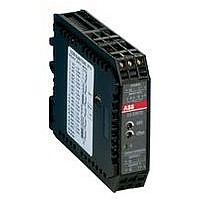1SVR011706R2200 ABB, 1SVR011706R2200 Datasheet - Page 3

1SVR011706R2200
Manufacturer Part Number
1SVR011706R2200
Description
55T7516
Manufacturer
ABB
Datasheet
1.1SVR010200R1600.pdf
(26 pages)
Specifications of 1SVR011706R2200
Input Type
PT100 Temperature Sensors
Output Accuracy
± 0.5%
No. Of Channels
1
Mounting Type
Din Rail
Isolation Input
Isolated
External Depth
102mm
External Length / Height
75mm
Rohs Compliant
Yes
Svhc
No SVHC (20-Jun-2011)
Applications for analog signal processing and
correct solution using CC-E and CC-U
converters
Nearly every process includes a control system that receives data
by means of analog signals and then evaluates the data and sets the
respective parameters correspondingly.
When transmitting analog signals numerous problems may arise which
can disturb or even block an ideal behavior of the process.
Below we have listed some processing problems together with the
respective solutions to solve these problems:
Signal conversion
Sometimes the available signals cannot be processed by the controller
or the actuator. In this case, signal converters are required to convert
the input signal (or different input signals) to the desired output signal.
Signal amplifi cation
If long lines or high burdens have to be operated, it may be necessary
to amplify the signal. CC analog signal converters require only low in-
put power and provide high output power.
Thus, there are no restrictions for the converter's position on the line,
i.e. it can be used
Signal fi ltering
Particularly on long lines or in rough industrial environments the signals
are exposed to high electromagnetic interferences. The frequency of
the coupled interference signals may be in the range of the common
mains frequency (50 Hz) or even much higher (in case of frequency
converters). According to the specifi c requirements, analog signal
converters are available which provide reliable suppression of those
interferences by means of an input low-pass fi lter.
½ existing
Approvals
Marks
A
A
E
existing for some devices
pending
a
K
½
½
b
for signal refreshing
(low input power)
or for signal amplifi cation
(high output power).
UL 508, CAN/CSA C22.2 No.14
UL 1604 (Class I, Div 2, hazardous locations),
CAN/CSA C22.2 No.213
CB scheme
CCC
CE
C-Tick
at the end of the line
at the beginning of the line
Analog signal converters
CC range
Application, Approvals and marks
½
½
½
½
½
½
½
½
½
½
½
½
½
½
½
½
½
½
Signal separation
½
½
½
½
½
½
Analog signal converter
Protection against overvoltage
Protection against ground loops
(e.g. CC-E or CC-U)
The increased use of micro-electronics make controls much more
sensitive against overvoltages, resulting from lightning discharges
or switching processes. Suppression diodes are incorporated in
the input of the CC analog signal converters which enable the
converters to arrest overvoltages with low energy level (resulting
from switching processes) by themselves. The products further-
more provide electrical isolation between input, output and sup-
ply circuit for protection of the controller connected to the output.
If components are used which refer to ground, the measuring
signals can be falsifi ed by a so-called ground loop. In this case,
certain parts of the signal are transmitted via earth and not via the
analog transmission line, thus causing incorrect evaluation of the
signal. The electrical isolation between the input and the output
disconnects these ground loops and thus enables correct signal
transmission.
½
½
½
½
½
1.
100 m
½
½
½
0-20 mA
½
½
½
½
Measuring sensor
0-10 V
½
½
½
½
½
½
½
½
Controller
e.g. AC500
½
½
½
½
½
½
½
0-10 V
½
½
½
½
100 m
4-20 mA
Analog signal converter
Actuator
(e.g. CC-E or CC-U)
2CDC110004C0207
2.
5/5
5












